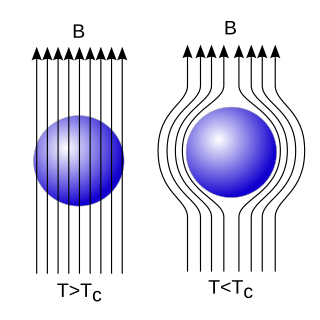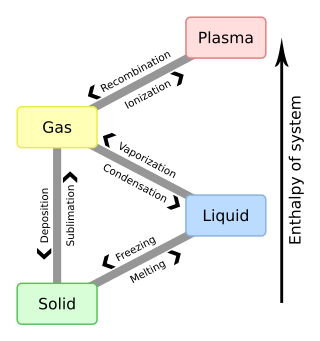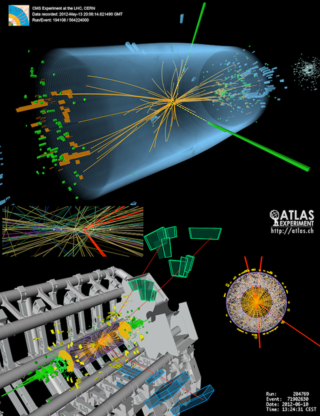
The Meissner effect is the expulsion of a magnetic field from a superconductor during its transition to the superconducting state when it is cooled below the critical temperature. This expulsion will repel a nearby magnet.

In chemistry, thermodynamics, and other related fields, a phase transition is the physical process of transition between one state of a medium and another. Commonly the term is used to refer to changes among the basic states of matter: solid, liquid, and gas, and in rare cases, plasma. A phase of a thermodynamic system and the states of matter have uniform physical properties. During a phase transition of a given medium, certain properties of the medium change as a result of the change of external conditions, such as temperature or pressure. This can be a discontinuous change; for example, a liquid may become gas upon heating to its boiling point, resulting in an abrupt change in volume. The identification of the external conditions at which a transformation occurs defines the phase transition point.

Spontaneous symmetry breaking is a spontaneous process of symmetry breaking, by which a physical system in a symmetric state spontaneously ends up in an asymmetric state. In particular, it can describe systems where the equations of motion or the Lagrangian obey symmetries, but the lowest-energy vacuum solutions do not exhibit that same symmetry. When the system goes to one of those vacuum solutions, the symmetry is broken for perturbations around that vacuum even though the entire Lagrangian retains that symmetry.
In gauge theory and mathematical physics, a topological quantum field theory is a quantum field theory which computes topological invariants.
In particle and condensed matter physics, Goldstone bosons or Nambu–Goldstone bosons (NGBs) are bosons that appear necessarily in models exhibiting spontaneous breakdown of continuous symmetries. They were discovered by Yoichiro Nambu in particle physics within the context of the BCS superconductivity mechanism, and subsequently elucidated by Jeffrey Goldstone, and systematically generalized in the context of quantum field theory. In condensed matter physics such bosons are quasiparticles and are known as Anderson–Bogoliubov modes.

In the Standard Model of particle physics, the Higgs mechanism is essential to explain the generation mechanism of the property "mass" for gauge bosons. Without the Higgs mechanism, all bosons (one of the two classes of particles, the other being fermions) would be considered massless, but measurements show that the W+, W−, and Z0 bosons actually have relatively large masses of around 80 GeV/c2. The Higgs field resolves this conundrum. The simplest description of the mechanism adds a quantum field (the Higgs field) that permeates all space to the Standard Model. Below some extremely high temperature, the field causes spontaneous symmetry breaking during interactions. The breaking of symmetry triggers the Higgs mechanism, causing the bosons it interacts with to have mass. In the Standard Model, the phrase "Higgs mechanism" refers specifically to the generation of masses for the W±, and Z weak gauge bosons through electroweak symmetry breaking. The Large Hadron Collider at CERN announced results consistent with the Higgs particle on 14 March 2013, making it extremely likely that the field, or one like it, exists, and explaining how the Higgs mechanism takes place in nature. The view of the Higgs mechanism as involving spontaneous symmetry breaking of a gauge symmetry is technically incorrect since by Elitzur's theorem gauge symmetries can never be spontaneously broken. Rather, the Fröhlich–Morchio–Strocchi mechanism reformulates the Higgs mechanism in an entirely gauge invariant way, generally leading to the same results.

In quantum field theory, the quantum vacuum state is the quantum state with the lowest possible energy. Generally, it contains no physical particles. The word zero-point field is sometimes used as a synonym for the vacuum state of a quantized field which is completely individual.
In quantum field theory, the term moduli is sometimes used to refer to scalar fields whose potential energy function has continuous families of global minima. Such potential functions frequently occur in supersymmetric systems. The term "modulus" is borrowed from mathematics, where it is used synonymously with "parameter". The word moduli first appeared in 1857 in Bernhard Riemann's celebrated paper "Theorie der Abel'schen Functionen".
In quantum mechanics, superselection extends the concept of selection rules.
In theoretical physics, the 't Hooft–Polyakov monopole is a topological soliton similar to the Dirac monopole but without the Dirac string. It arises in the case of a Yang–Mills theory with a gauge group G, coupled to a Higgs field which spontaneously breaks it down to a smaller group H via the Higgs mechanism. It was first found independently by Gerard 't Hooft and Alexander Polyakov.

In physics, symmetry breaking is a phenomena where a disorderly, but symmetric state collapses into a more coherent, but asymmetric whole. This collapse is often one of many possible bifurcations that a particle can take as it approaches a lower energy state. Due to these many possibilities, an observer may assume the result of the collapse arbitrary. This phenomena is fundamental to quantum field theory, and further, contemporary understandings of physics.

In general relativity, an exact solution is a solution of the Einstein field equations whose derivation does not invoke simplifying assumptions, though the starting point for that derivation may be an idealized case like a perfectly spherical shape of matter. Mathematically, finding an exact solution means finding a Lorentzian manifold equipped with tensor fields modeling states of ordinary matter, such as a fluid, or classical non-gravitational fields such as the electromagnetic field.
The QCD vacuum is the vacuum state of quantum chromodynamics (QCD). It is an example of a non-perturbative vacuum state, characterized by non-vanishing condensates such as the gluon condensate and the quark condensate in the complete theory which includes quarks. The presence of these condensates characterizes the confined phase of quark matter.
Erick J. Weinberg is a theoretical physicist and professor of physics at Columbia University.

Physics beyond the Standard Model (BSM) refers to the theoretical developments needed to explain the deficiencies of the Standard Model, such as the inability to explain the fundamental parameters of the standard model, the strong CP problem, neutrino oscillations, matter–antimatter asymmetry, and the nature of dark matter and dark energy. Another problem lies within the mathematical framework of the Standard Model itself: the Standard Model is inconsistent with that of general relativity, and one or both theories break down under certain conditions, such as spacetime singularities like the Big Bang and black hole event horizons.

The Higgs boson, sometimes called the Higgs particle, is an elementary particle in the Standard Model of particle physics produced by the quantum excitation of the Higgs field, one of the fields in particle physics theory. In the Standard Model, the Higgs particle is a massive scalar boson with zero spin, even (positive) parity, no electric charge, and no colour charge that couples to mass. It is also very unstable, decaying into other particles almost immediately.
In quantum field theory, gauge gravitation theory is the effort to extend Yang–Mills theory, which provides a universal description of the fundamental interactions, to describe gravity.
Bumblebee models are effective field theories describing a vector field with a vacuum expectation value that spontaneously breaks Lorentz symmetry. A bumblebee model is the simplest case of a theory with spontaneous Lorentz symmetry breaking.
In quantum field theory and statistical field theory, Elitzur's theorem states that in gauge theories, the only operators that can have non-vanishing expectation values are ones that are invariant under local gauge transformations. An important implication is that gauge symmetry cannot be spontaneously broken. The theorem was proved in 1975 by Shmuel Elitzur in lattice field theory, although the same result is expected to hold in the continuum. The theorem shows that the naive interpretation of the Higgs mechanism as the spontaneous symmetry breaking of a gauge symmetry is incorrect, although the phenomenon can be reformulated entirely in terms of gauge invariant quantities in what is known as the Fröhlich–Morchio–Strocchi mechanism.

Superfluid vacuum theory (SVT), sometimes known as the BEC vacuum theory, is an approach in theoretical physics and quantum mechanics where the fundamental physical vacuum is considered as a superfluid or as a Bose–Einstein condensate (BEC).







